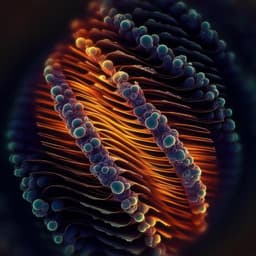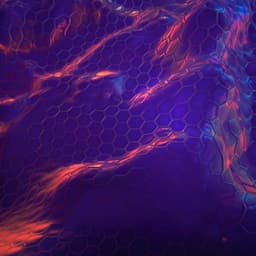
Physics
Gate controlled valley polarizer in bilayer graphene
H. Chen, P. Zhou, et al.
Discover how sign reversal of Berry curvature in bilayer graphene leads to counter-propagating 1D channels with distinct valley indices. This groundbreaking research, conducted by Hao Chen, Pinjia Zhou, Jiawei Liu, Jiabin Qiao, Barbaros Oezyilmaz, and Jens Martin, achieves impressive conductance differences without requiring an external magnetic field—unlocking new possibilities for future experiments.
~3 min • Beginner • English
Introduction
The study targets electrical generation and control of valley-polarized one-dimensional channels in bilayer graphene without applying an external magnetic field. The valley degree of freedom in graphene, arising from the hexagonal lattice and associated Berry curvature, is of interest for valleytronic devices such as filters, beam splitters, and waveguides. Conventional detection of valley currents often relies on non-local measurements and the inverse valley Hall effect, which is indirect. Theory predicts that dual-split gates creating adjacent regions with opposite displacement fields produce a sign reversal of Berry curvature and topologically protected counter-propagating 1D channels that are valley polarized, with expected quantized conductance of 4e^2/h in the ballistic limit. Prior experiments achieved strong contrast only under magnetic fields that separate counter-propagating channels, but high fields push ungated regions into the quantum Hall regime, limiting applications. The purpose here is to realize robust, gate-controlled valley-polarized transport at zero magnetic field through optimized device geometry and fabrication to suppress disorder and valley mixing.
Literature Review
The paper situates its work within efforts to create and detect valley currents in 2D materials. Valley currents have been generated optically (e.g., in MoS2) and controlled magnetically in transition metal dichalcogenides, but these methods can be impractical for electronic devices. In graphene and bilayer graphene, non-local measurements have probed valley Hall currents, and topological valley transport has been observed at natural stacking domain walls. Theory proposed that sign reversal of Berry curvature across dual-gated regions in bilayer graphene yields topological 1D channels (zero-line modes) with valley polarization and fourfold degeneracy. Earlier gate-controlled experiments suffered from disorder-induced valley mixing and required strong magnetic fields to approach ballistic transport, showing four quantized channels only at ~8 T. Additional literature covers subband formation in confined graphene systems, disorder levels in hBN-encapsulated devices, edge contacts, and transport phenomena such as anti-Klein tunneling and Fabry-Perot interference in gapped bilayer graphene.
Methodology
The authors combined electrostatic simulations, optimized device fabrication, and low-temperature transport measurements. Electrostatic modeling: A finite element electrostatic model (MATLAB PDE toolbox) solves Poisson's equation to estimate induced charge and displacement fields in dual-split gate geometries. Gates are treated as metallic rectangles (few-layer graphene bottom gates ~2.5 nm thick; metal top gates ~25 nm), and bilayer graphene is approximated as a metal to obtain an upper bound on induced charge. The study varies gate spacing and dielectric thicknesses to quantify charge inhomogeneity from asymmetric gating and to guide top-gate spacing adjustments minimizing gate-induced charge disorder. Device fabrication: Heterostructures of hBN/BLG/hBN are assembled by dry van der Waals stacking onto pre-patterned few-layer graphene split bottom gates. To achieve nominal ~50 nm split channels, the team compensates for processing-induced dimension changes: bottom gate gaps are etched to ~35 nm (oxygen plasma with PMMA mask), while top gate gaps are written to ~65 nm (slight EBL overdose to reduce residues), yielding effective ~50 nm splits. Alignment accuracy is better than 5 nm. The device includes four gate pairs to enhance yield and enable analyzer experiments. After stacking, devices are etched into ~1 um-wide ribbons and contacted via edge contacts. SEM verifies split gaps (50 ± 5 nm). Electrical measurements: Two-terminal measurements at T = 1.4 K map resistance versus top and bottom gate voltages, recast into charge density n and displacement field D using device-specific dielectric constants, thicknesses, and voltage offsets. The mean free path (~330 nm and ~700 nm in devices 1 and 2) is comparable to the gate length (400 nm), indicating near-ballistic transport across the gated region. To quantify chiral channel conductance, the authors subtract a series resistance estimated from high-density measurements (ungated BLG sheet resistance plus contact resistance). Valley analyzer configuration: Two adjacent split gate pairs are biased such that the first acts as a polarizer (fixed odd-field configuration), while the second is tuned to be either same or opposite valley polarization. The measured resistance contrast between these settings tests the chiral, valley-polarized nature of the channels. Methods section details EBL parameters, plasma etch conditions, AFM cleaning of gates, stacking procedure, and mobility extraction.
Key Findings
- Zero-field valley polarizer performance: Electrical measurements show up to two orders of magnitude difference in conductance between valley-polarized (odd-field) and gapped (even-field) states. The valley-polarized state exhibits conductance approaching 4e^2/h.
- Resistance behavior: In odd-field configurations, device resistance versus displacement field saturates at a plateau ~11 kOhm (device 1). In even-field configurations, resistance increases exponentially (linear in log scale) to ~600 kOhm at D ~ 1.1 V/nm, yielding an estimated transport gap ~0.69 meV at that field.
- Reversed polarity: With opposite fixed-gate polarity, similar behavior occurs; the resistance ratio between odd and even configurations reaches ~100, and the insulating gap reaches ~0.42 meV at D ~ 1.4 V/nm.
- Channel conductance estimate: After subtracting a high-density series resistance R_high density ~5.48 kOhm, the derived odd-field channel resistance is ~5.72 kOhm, close to the expected h/4e^2 ~6.45 kOhm (about 15% more conductive), suggesting near-ballistic four-channel transport with possible minor parallel conduction.
- Device quality: Field-effect mobility ~150,000 and ~320,000 cm^2 V^-1 s^-1 for devices 1 and 2; mean free paths ~330 nm and ~700 nm, comparable to the 400 nm gate length.
- Valley analyzer: Using two gate pairs, resistance is low when both gate pairs have the same valley polarization and high when opposite, demonstrating the chiral, valley-polarized nature of the odd-field channels at zero magnetic field.
- Geometry optimization impact: Electrostatic simulations indicate that asymmetric gating can induce charge disorder exceeding 1e10 cm^-2, but adjusting top-gate spacing can reduce induced charge by ~5x, bringing disorder to the level of typical hBN-encapsulated devices (~1e10 cm^-2).
Discussion
The results address the central question of realizing robust, gate-controlled valley-polarized transport in bilayer graphene without magnetic fields. By optimizing split-gate geometry and stacking to minimize asymmetric gating-induced charge disorder, the authors obtain near-ballistic one-dimensional channels in odd-field configurations with conductance close to 4e^2/h and strong on/off contrast (~100) relative to the insulating even-field states. The measured transport gaps in the even-field cases confirm effective bandgap opening under displacement fields, while the saturation and relatively low resistance in odd-field cases are consistent with topological zero-line modes that are valley polarized. A valley analyzer using a second gate pair yields higher resistance for opposite valley polarization and lower resistance for matching polarization, directly evidencing the chiral and valley-polarized nature of the channels at zero magnetic field. Some quantitative discrepancies, such as slightly higher-than-expected conductance for the chiral channels, are plausibly explained by series resistance estimation uncertainties and pn-junction effects (anti-Klein tunneling) that skew high-density resistance baselines, as well as potential residual inhomogeneous gating. Overall, the findings demonstrate that careful device design enables electrical control of valley degrees of freedom and paves the way for experiments probing transport under finite Berry curvature in zero field.
Conclusion
The study demonstrates a gate-controlled valley polarizer in bilayer graphene operating at zero magnetic field with near-ballistic, fourfold quantized 1D channels and strong contrast between valley-polarized and gapped states. Through electrostatic modeling-guided geometry optimization and high-quality hBN-encapsulated fabrication, the device achieves channel resistances close to h/4e^2 and conductance contrasts up to two orders of magnitude. A second gate pair functions as a valley analyzer, confirming the chiral, valley-polarized nature of the channels. These advances establish a practical pathway for electrically controllable valley transport and pseudo-spin manipulation. Future work will include detailed characterization of valley polarization using subsequent gate pairs as analyzers, further reduction of disorder and asymmetry in gate dielectrics and spacings, and integration into more complex valleytronic circuits and interferometers.
Limitations
- Sensitivity to device geometry: Achieving minimal induced charge disorder requires nanometer-precision control of top/bottom gate spacings and dielectric thicknesses; edge roughness, misalignment, and fabrication-induced over/underexposure can degrade performance.
- Residual disorder and inhomogeneity: Despite optimization, gating inhomogeneity and intrinsic disorder can reduce transport gaps and introduce parallel conduction in odd-field configurations.
- Transport gap magnitude: Extracted transport gaps are smaller than those in suspended bilayer graphene and comparable to SiO2-supported devices, potentially due to short channel length and residual inhomogeneity.
- Series resistance estimation: Two-terminal measurements require subtracting series resistance; uncertainties due to contact resistance, ungated sheet resistance, and pn vs nn' junction asymmetries (anti-Klein tunneling) can affect extracted channel conductance.
- Analyzer contrast: The valley analyzer exhibits moderate, not maximal, contrast between same and opposite polarization, indicating room for further suppression of backscattering and disorder.
Related Publications
Explore these studies to deepen your understanding of the subject.







